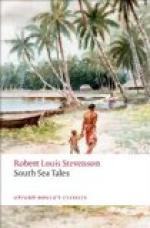Monday, July 29.—The great day came round at last. In the first hours the night was startled by the sound of clapping hands and the chant of Nei Kamaunava; its melancholy, slow, and somewhat menacing measures broken at intervals by a formidable shout. The little morsel of humanity thus celebrated in the dark hours was observed at midday playing on the green entirely naked, and equally unobserved and unconcerned.
The summer parlour on its artificial islet, relieved against the shimmering lagoon, and shimmering itself with sun and tinned iron, was all day crowded about by eager men and women. Within, it was boxed full of islanders, of any age and size, and in every degree of nudity and finery. So close we squatted, that at one time I had a mighty handsome woman on my knees, two little naked urchins having their feet against my back. There might be a dame in full attire of holoku and hat and flowers; and her next neighbour might the next moment strip some little rag of a shift from her fat shoulders and come out a monument of flesh, painted rather than covered by the hairbreadth ridi. Little ladies who thought themselves too great to appear undraped upon so high a festival were seen to pause outside in the bright sunshine, their miniature ridis in their hand; a moment more and they were full-dressed and entered the concert-room.
At either end stood up to sing, or sat down to rest, the alternate companies of singers; Kuma and Little Makin on the north, Butaritari and its conjunct hamlets on the south; both groups conspicuous in barbaric bravery. In the midst, between these rival camps of troubadours, a bench was placed; and here the king and queen throned it, some two or three feet above the crowded audience on the floor—Tebureimoa as usual in his striped pyjamas with a satchel strapped across one shoulder, doubtless (in the island fashion) to contain his pistols; the queen in a purple holoku, her abundant hair let down, a fan in her hand. The bench was turned facing to the strangers, a piece of well-considered civility; and when it was the turn of Butaritari to sing, the pair must twist round on the bench, lean their elbows on the rail, and turn to us the spectacle of their broad backs. The royal couple occasionally solaced themselves with a clay pipe; and the pomp of state was further heightened by the rifles of a picket of the guard.
With this kingly countenance, and ourselves squatted on the ground, we heard several songs from one side or the other. Then royalty and its guards withdrew, and Queen Victoria’s son and daughter-in-law were summoned by acclamation to the vacant throne. Our pride was perhaps a little modified when we were joined on our high places by a certain thriftless loafer of a white; and yet I was glad too, for the man had a smattering of native, and could give me some idea of the subject of the songs. One was patriotic, and dared Tembinok’ of Apemama, the terror of the group, to an invasion. One mixed




